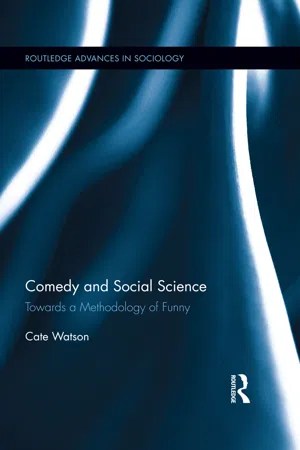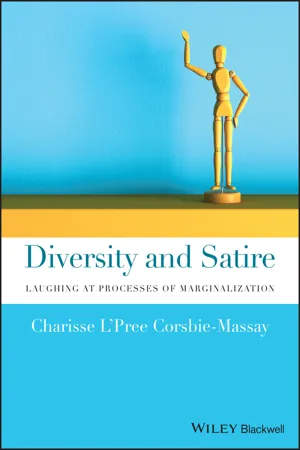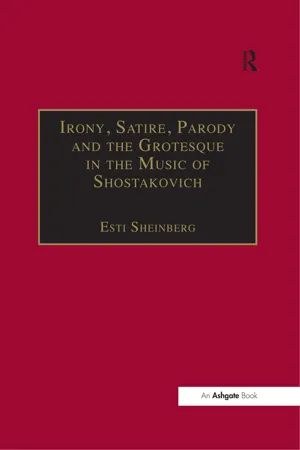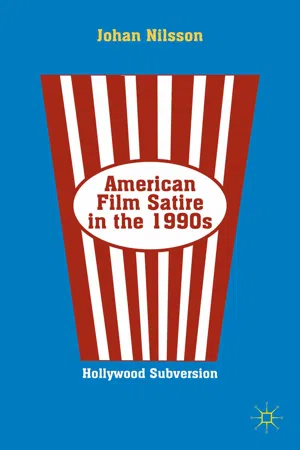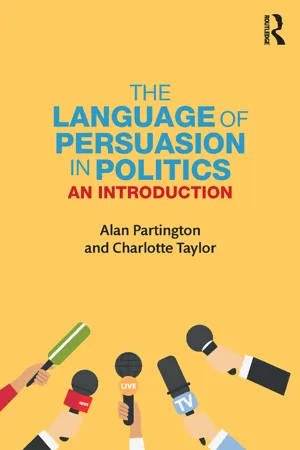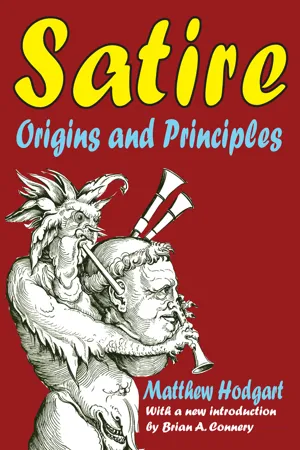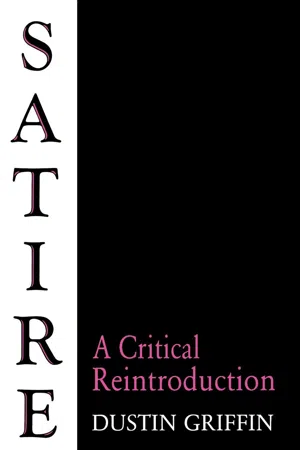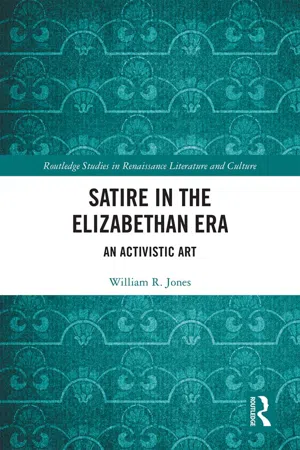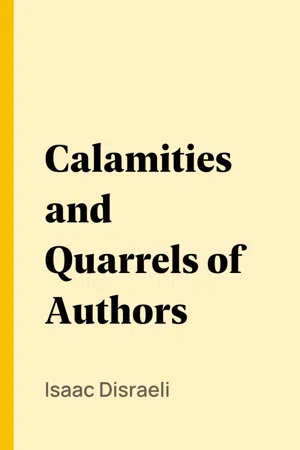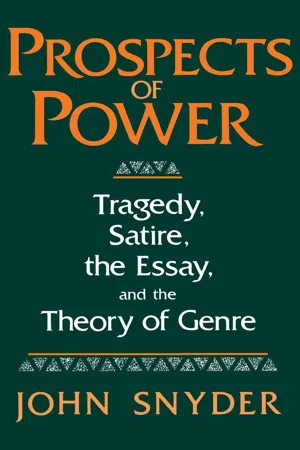Literature
Satire
Satire is a literary technique that uses humor, irony, or ridicule to criticize and expose the flaws of individuals, institutions, or society. It often employs exaggeration and parody to highlight the absurdities and vices of its targets. Through wit and sarcasm, satire aims to provoke reflection and change by challenging prevailing attitudes and behaviors.
Written by Perlego with AI-assistance
12 Key excerpts on "Satire"
- eBook - ePub
Comedy and Social Science
Towards a Methodology of Funny
- Cate Watson(Author)
- 2015(Publication Date)
- Routledge(Publisher)
4 Satire DOI: 10.4324/9781315731407-4INTRODUCTION
Satire has been defined as ‘a literary manner which blends a critical attitude with humour and wit to the end that human institutions or humanity may be improved’ (Holman, 1980 , p. 398). Holman continues, ‘True satirists are conscious of the frailty of institutions of human devising and attempt through laughter not so much to tear them down as to inspire a remodeling’. While irony, as a rhetorical trope which exerts its effects through juxtaposition and the creation of incongruity, constitutes a potential analytical tool in the social sciences, Satire may be considered a genre, mode of writing, or narrative form, a means for and of representation. In overly simplistic terms, then, irony contributes to the development of theory whereas Satire functions as a form of critique, achieving its ends through challenging our assumptions by making them appear ridiculous (Bronowski and Mazlish, 1960 ).Satire is undoubtedly dangerous stuff. Ancient beliefs in the magical powers of Satire for good and ill were once widespread (Elliott, 1954 ). Satire could literally be hurled as invective against one’s enemies or used to expel evil. That satirists could ‘rhyme rats to death’ (Todd and Curry, 1850 ) was apparently a commonplace belief in ancient and medieval times, referred to by Shakespeare and others and the possible source of the legend of the Pied Piper of Hamelin.While satirists may no longer be feared for their terrible power, ruthlessly exercised—rats may sleep easy in their nests—the metaphor of Satire as weapon persists. It is perhaps Satire’s conceit to present this as having moral purpose, ‘prompting men of genius and virtue, to mend the World, as far as they are able’ (Swift, 1730 , p. 21). Such an aim would accord with a critical research tradition. However, this claim to moral purpose gives rise to a number of problems for the satirically inclined social scientist. First, as Veatch (1998 - eBook - ePub
Diversity and Satire
Laughing at Processes of Marginalization
- Charisse L'Pree Corsbie-Massay(Author)
- 2022(Publication Date)
- Wiley-Blackwell(Publisher)
1 Defining Satire“Satire is a wrapping of exaggeration around a core of reality”.–Barbara W. TuchmanWe live in a satirical age unlike any other. There is an abundance of social absurdities to critique as well as a host of outlets through which to speak out. In the twenty-first century, Satire is mainstream and avant-garde. Long-running network shows, like Saturday Night Live (1975–present) and The Simpsons (1989–present), cable television offerings like Comedy Central’s The Daily Show (1996–present) and Cartoon Network’s Adult Swim, and popular and critically acclaimed independent films like Get Out (2017) and Parasite (2019) keep satirical content at the center of today’s entertainment industry. At the same time, social media has led to an explosion of user-generated Satire that can be tailored to niche and intersectional audiences, especially those whose voices have not traditionally been embraced by and in mainstream media.Regrettably, this flood of satirical content has exacerbated a long-standing issue for American audiences: The ability to distinguish and appreciate Satire. This confusion is particularly troubling for Satire that addresses issues related to marginalization, diversity, and inclusion. Even though discussions of social justice are prevalent in the public sphere, content that satirizes these processes is increasingly difficult to create and understand. This chapter will define Satire as well as a set of satirical strategies before describing how Satire serves to disrupt marginalization processes and the difficulties that satirists face in ensuring that their audiences understand their messages.What Is Satire?
Satire - eBook - ePub
Irony, Satire, Parody and the Grotesque in the Music of Shostakovich
A Theory of Musical Incongruities
- Esti Sheinberg(Author)
- 2017(Publication Date)
- Routledge(Publisher)
The vertical axis is the axis of criticism, with progression from Reality to Fiction, and it is designed to include the characteristic which distinguishes satirical literature from other types of literature on the one hand, and from non-literature on the other. Satire is the meeting point of criticism and humor in a literary work. This meeting point is already expressed in the concept of ridicule, but ridicule does not always equal Satire. Finally, Satire is also situated somewhere between literature proper (Fiction), where the literary text does not necessarily enter into referential relationship with the world, and non-literature (Reality), where, as in everyday speech, there is a clear referential relationship. An ideal Satire should be situated closer to, rather than farther from the intersection of the two axes (Petro, 1982: 128) As in the case of irony, most writers on Satire use various and sometimes overlapping terms to describe its specific ramifications: burlesque, irony, the grotesque, parody and even tragedy are constantly interchanged with Satire. Within all this variety, however, there is one general agreement: Satire relies on a given set of norms, and uses ridicule, often in an aggressive manner, to indicate actual instances of failure to match their standards (Pollard, 1970: 3; Nichols, 1971: 14, 18; Fletcher, 1987: ix). The norms of Satire are characteristically (though not necessarily!) related to ethical and social values (Pollard, 1970: 7). Thus Satire bears a historical, reality-related character, and is therefore never totally fictional (Petro, 1982: 128). The simplest case of Satire would then be a phenomenon that, being incongruous with an accepted norm, is ridiculed - eBook - ePub
American Film Satire in the 1990s
Hollywood Subversion
- J. Nilsson(Author)
- 2013(Publication Date)
- Palgrave Macmillan(Publisher)
NTRODUCTION[A] new subject matter demands new form, and as good a way as any toward understanding what a film is trying to say to us is to know how it is saying it.—André Bazin1T his book is about Satire—that seemingly elusive mode of representation that has been used to mock and ridicule society and culture for thousands of years. From its earliest incarnation, Satire was associated not only with the written word, but also with public performance.2 Over time Satire has come in many forms and genres as well as in different types of media (verse, drama, rhetorical performance, prose, cartoons, journalism, film, TV, Internet), making it quite difficult to encapsulate.3 Indeed, the stylistic and formal variety that is possible within the “framework” of Satire precludes defining it as a clearly delimitated unit. As early as 1960 Robert C. Elliott wrote that “[w]e shy from using the category ‘a Satire’ today, at least when we are trying to speak precisely, because the term has lost for us any sense of formal specification.”4 If this was the case in 1960, imagine what has happened to Satire since then, as the media landscape has grown ever larger and more varied.Satire has traditionally been defined as a moral and rhetorical art that attacks vice and folly through wit and ridicule.5 Like all cultural forms, it has had both its detractors and its defenders. Much of the controversy around Satire stems from its relationship to morality: Does the satirist have the right to attack society? Is his or her critique justified and does it conform to a moral standard? Who is the satirist and who is satirized? These are not questions that this study attempts to answer in any explicit sense, but they do actualize issues concerning the satirist’s social, political, and cultural role at any given time. This,in turn, implies that some type of connection to historical reality is emphasized when it comes to Satire. The notion of Satire as a moral form and as a rhetorical art, Dustin Griffin tells us, was in fact put forth as long ago as 1693 by the English satirist John Dryden. Griffin moves away from the general works on Satire produced during the 1960s (where the moral center of Satire was continually emphasized) and points to more specialized fare from individual satirists, in whose works the complexities and ambiguities of the form are considered.6 - eBook - ePub
The Language of Persuasion in Politics
An Introduction
- Alan Partington, Charlotte Taylor(Authors)
- 2017(Publication Date)
- Routledge(Publisher)
Taylor (2016) notes that sarcasm is not always judged to be a bad thing. She observed how participants in online forums sometimes referred to their own behaviour as ‘sarcastic’ and portrayed it as a justifiable response to some other person’s aggressive verbal behaviour towards them. Politicians too may pride themselves on their ability to display aggression in a way that is considered both acceptable and entertaining.It may also be viewed as entertaining by those who are not the target, as in the following instance from the UK House of Lords:I have to thank the noble Lord, Lord Carlile of Berriew, for his colourful combination of irony and sarcasm, which I so often enjoyed listening to when he was a Member in another place.(House of Lords 2003)9.3 Definitions of SatireHumour in politics is often associated with Satire: Satire is a work ‘in which wickedness or folly is censured’ (Johnson 1755). It is a written or spoken form ‘in which human or individual vices, follies, abuses, or shortcomings are held up to censure by means of ridicule, derision, burlesque, irony or other methods’ (Encyclopedia Britannica, www.britannica.com/art/satire ). Various mock satirical ‘newspapers’ or news TV are available online; for example, The Onion satirises current affairs from a US perspective, The Daily Mash and NewsThump from a UK angle.In the terms adopted in this book, Satire is also a means of persuasion. A person, behaviour or state of affairs is criticised (evaluated unfavourably) in the hope of persuading an audience that something has to change.Moreover:• In political Satire, individuals or groups who possess power, authority or at least influence - eBook - ePub
- Massih Zekavat, Tabea Scheel(Authors)
- 2023(Publication Date)
- Routledge(Publisher)
This is frequently achieved through the use of different rhetorical devices in literature. Moreover, Satire usually presumes a standard moral system as a norm in comparison to which deviations and (moral) failures are detected and exposed. As a result, Satire has been frequently conceptualized at the juncture between moral philosophy and rhetoric. Nonetheless, it has never been restricted to the traditional medium of rhetoric, namely language. Not only has it resurfaced in many genres like the novel, but it has also permeated over other media including pictorial arts and motion pictures. Among other things, its use in personal attacks also shows that it has not always strictly adhered to the moral and ethical codes it aims to uphold (for more on Satire, see Baumgarten & Morris, 2008 ; Bloom & Bloom, 1979 ; Condren, 2002, 2012, 2017; Condren et al., 2008 ; Connery & Combe, 1995 ; Davis, 2016, 2017; Declercq, 2018 ; Elliott, 1954, 1960 ; Feinberg, 1967 ; Frye, 1973 ; Greenberg, 2011, 2019 ; Griffin, 1994 ; Guilhamet, 1987 ; Highet, 1960, 1962 ; Hodgart, 2017 ; Hume, 2007 ; Jav ā d ī, 2005; Kernan, 1959, 1965 ; Knight, 2004 ; LaMarre et al., 2014 ; Marshall, 2013 ; McCausland et al., 2008 ; Meijer Drees & De Leeuw, 2015 ; Paulson,. 1967 ; Phiddian, 2013, 2019; Quintero, 2007 ; Simpson, 2003 ; Sloterdijk, 2001 ; Sutherland, 1962 ; Test, 1991 ; Twark, 2007 ; Zekavat, 2014, 2017, 2019a, 2019b). In literary and cultural studies, several critics have acknowledged the disciplinary, parrhesiastic, liberating, and revolutionary functions of Satire (Bakhtin, 1984 ; Brock, 2018 ; Colebrook, 2004 ; Eagleton, 2019 ; Hoffman & Young, 2011 ; Holm, 2017 ; Hutcheon, 2005 ; Kozintsev, 2010 ; McGraw & Warren, 2014; Nikulin, 2014 ; Phiddian, 2017 ; Rolfe, 2017 ; Sørensen, 2016 ; Takovski, 2019 ; Waterlow, 2015, 2018 ; Young, 2012, 2020 ; Zekavat, 2017 ; Zupan č i č, 2008). Chattoo (2019, p - eBook - ePub
Satire
Origins and Principles
- Matthew Hodgart(Author)
- 2017(Publication Date)
- Routledge(Publisher)
If we demand and receive from even the simplest classic novel so many different things, this is inconsistent with the simplicity of Satire. Whereas the novelist aims at understanding the complexities oflife, Satire aims at simplification, at a pretence of misunderstanding and at denunciation. The sheer size of the open-ended form of the novel has also much to do with the difficulty that satirists have in using it: Satire seems to require a light and closed form which helps to make a simple point effectively - the form is itself a component of the wit without which Satire is unbearable. It follows that no full-length novel is likely to be satirical throughout, and indeed not one example among the classics comes to mind. SatiricalWyndham Lewis himself illustrated his satirical novel The Apes of God, in curiously abstract style for such a personal view of the literary scene.fiction if it is to be successful needs to be short and also to approach one of the traditional forms discussed above - the folk allegory, imaginative voyage, Utopia or some version of these genres. At the same time, Satire may appear at almost any point in a serious novel, to provide extra attack on one of the main themes, to emphasise one of the moral points or to change the level of representation from factual documentary to imaginative travesty. This is to say nothing of the straight lampoons or attacks on real people, which appear in many novels: novelists evidently cannot resist the temptation to pillory their acquaintances, especially their literary enemies. Thus D.H.Lawrence gives a serious but distorted picture of Middleton Murry in Women in Love , Aldous Huxley has a hilarious caricature of Murry in Point Counter Point , while Wyndham Lewis assaulted the Sitwells in The Apes of God - eBook - ePub
Satire
A Critical Reintroduction
- Dustin Griffin(Author)
- 2021(Publication Date)
- The University Press of Kentucky(Publisher)
In the late fourth century the grammarian Diomedes defined Satire as “a verse composition . . . defamatory and composed to carp at human vices” (maledicum et ad carpenda hominum vitia). 14 Furthermore, he has in mind only the tradition of Roman verse Satire as written by Lucilius, Horace, and Persius (whom he names), omitting the Varronian or Menippean tradition altogether. Though he acknowledges Satire’s complex etymology, from satyrs or the lanx satura or the lex satura, 15 Diomedes defines the form in wholly moral terms. He says nothing of wit, humor, playfulness, exaggeration or fantasy or paradox, iconoclasm or the carnival spirit. It is ultimately writers like Diomedes, reflecting what G.L. Hendrickson called the “moral obsession of literary criticism in later antiquity,” 16 who lead more or less directly to the emphasis on Satire’s moral function that dominates satiric theory from the Renaissance into the mid-twentieth century. Elizabethan Theory Sixteenth-century English writers on Satire inherited several different traditions: a broad medieval tradition of “complaint” 17 that ranged in English alone from Langland and Chaucer to Barclay and Skelton; Lucianic dialogues, once prized for their sophistication but by the Reformation increasingly associated with scoffing atheism; a line of epistolary Satire in Italy from Vingiguerra to Alamanni and Ariosto, based primarily on Horatian models. Oddly enough, with all this wealth of living tradition and despite the recovery of classical Roman formal Satire, the dominant theory of Satire among Renaissance writers was based on their notion of Greek satyr plays (of which they knew almost nothing), a theory that could account for very little of the Satire with which they were familiar - eBook - ePub
Satire in the Elizabethan Era
An Activistic Art
- William Jones(Author)
- 2017(Publication Date)
- Routledge(Publisher)
1 Satire, History, and IdeologyI like it that jokes can hurt. I like it that [North Korean leader] Kim Jong-un was wounded by a movie. [i.e. The Interview , Sony Pictures, 2014] If you’re a satirist, that’s winning.1—Bill Maher, Real Time with Bill Maher (HBO)In 1964, United States Supreme Court Justice Potter Stewart famously remarked that although he was unable to define precisely the distinguishing characteristics of obscenity, “I know it when I see it,” and this same intuitive response is often applied to the understanding of Satire. At some point during a novel or a film, a play or a television program, a poem or a song, whether comic, tragic, romantic, etc., readers and auditors will be suddenly struck by an awareness that the work in question was merely a ruse, a host fiction employed by a parasite lying within, waiting to leap forth and skewer its unsuspecting victims. What, then, is it, precisely, that sets off the Satire alarm bell? A consistent critical perspective and manifest targets are two potential factors that alert us to Satire’s presence, but when pressed to codify other defining features of ‘Satire,’ or to identify a specific tipping point that morphs a genre containing satiric elements into a Satire proper, readers and scholars often find themselves adrift in a sea of subjective judgments. Because of its antagonistic nature and concomitant need for self-protection, perhaps more than any other artistic genre—a problematic term, because while Satire has qualities and antecedents that grant it the vaunted status of genre, it can, and often does, function more like a mode, a form, a tone, an attitude, or as Charles Knight describes it, a “frame of mind” shared between author and reader—Satire regularly defies, subverts, and manipulates attempts to impose clarity and uniformity on its farraginous practices.2 - eBook - ePub
- Penelope J Corfield, Penelope J. Corfield(Authors)
- 2012(Publication Date)
- Routledge(Publisher)
This was the fertile context in which Hogarth, Rowlandson, Gillray and Cruikshank flourished. Even in polite conversation, a lively, bantering style of wit was acceptable, if used with due discretion, while buffoonery, coarse humour and guffawing was deprecated. 5 To scoff lightly at known targets for criticism was a viable formula for social exchange, easily understood and repeated. In that spirit, for example, the 4th Earl of Chesterfield noted that: ‘Many young people think it very genteel and witty to abuse the clergy.’ He rejected this as unwise but added his own quiet demystification of ministers of the cloth: ‘They [the young] are extremely mistaken; since, in my opinion, parsons are very like men, and neither the better nor the worse for wearing a black gown.’ 6 Targets for Satire were highly stereotyped. They included both individuals and generic characters, or (as in the case of Pope’s victims in The Dunciad) individuals who could also be taken as prototypes. Above all, Satire was used to probe at issues, actions and areas of social life that were seen as problematic. Its art required a keen awareness of the subject for critique. Freud argued that Satire and invective – what he termed ‘hostile wit’ – acts as an indirect form of aggression, aimed at hurting not by force but by humiliation and ridicule; and it is thus well adapted for attacks by the relatively powerless against the powerful. 7 It was also enjoyable simply as humour. Certainly, in eighteenth- and early nineteenth-century Britain, a quotient of Satire and irreverence was thereby incorporated into cultural traditions: If the knowing well how to expose any Infirmity or Vice were but a sufficient Security for the Vertue which is contrary, how excellent an Age might we be presum’d to live in! [wrote Shaftesbury in 1711] - eBook - ePub
- Isaac Disraeli, Disraeli, Benjamin, Earl of Beaconsfield, (Authors)
- 2009(Publication Date)
- Perlego(Publisher)
LITERARY RIDICULE.
ILLUSTRATED BY SOME ACCOUNT OF A LITERARY Satire.
Ridicule may be considered as a species of eloquence; it has all its vehemence, all its exaggeration, all its power of diminution; it is irresistible! Its business is not with truth, but with its appearance; and it is this similitude, in perpetual comparison with the original, which, raising contempt, produces the ridiculous.There is nothing real in ridicule; the more exquisite, the more it borrows from the imagination. When directed towards an individual, by preserving a unity of character in all its parts, it produces a fictitious personage, so modelled on the prototype, that we know not to distinguish the true one from the false. Even with an intimate knowledge of the real object, the ambiguous image slides into our mind, for we are at least as much influenced in our opinions by our imagination as by our judgment. Hence some great characters have come down to us spotted with the taints of indelible wit; and a satirist of this class, sporting with distant resemblances and fanciful analogies, has made the fictitious accompany for ever the real character. Piqued with Akenside for some reflections against Scotland, Smollett has exhibited a man of great genius and virtue as a most ludicrous personage; and who can discriminate, in the ridiculous physician in “Peregrine Pickle,” what is real from what is fictitious?[80]115The banterers and ridiculers possess this provoking advantage over sturdy honesty or nervous sensibility—their amusing fictions affect the world more than the plain tale that would put them down. They excite our risible emotions, while they are reducing their adversary to contempt—otherwise they would not be distinguished from gross slanderers. When the wit has gained over the laughers on his side, he has struck a blow which puts his adversary hors de combat - eBook - ePub
Prospects Of Power
Tragedy, Satire, the Essay, and the Theory of Genre
- John Snyder(Author)
- 2021(Publication Date)
- The University Press of Kentucky(Publisher)
satura .Yet in Satire that is proportionally more political in its subject matter—as during the late seventeenth, the eighteenth, and the late nineteenth centuries—than it is social or moral or religious, generic instability is more complex in its effects on meaning. This instability is sometimes the result of the employment of antithetical techniques in the same work, sometimes the consequence of political thematics. It will be remembered that political power as symbolically incursive action drives its imitations in tragedies on straight tracks leading to victory, loss, or dead end. However, Satire, as a genre of rhetorical attitudinalizing, channels power toward clearly visible ends only if it remains concentrated on rational critique, whether applied to moral, social, or religious experience; and we have already seen how even such highly visible targets can fade, so that new, nonsatiric perspectives are disclosed as a work unfolds.If “political” in the context of generic differentiation characterizes something special in Satire, the reason must lie in what makes politics itself distinct from history in general and from particular moral, social, and religious attitudes. “Politics” I take, then, to apply to the traces, more pronounced in certain Satires than others, of programmatic action and ideology. Of course, most Satire has political implications, from the saturae of Romans fearful for their lives to the Satires of the blithe English Augustans and the deadly direct Swift. But when the satiric voice identifies itself with parties and affiliated ideologies bearing time-bound labels, such as Swift’s “Tory” or Twain’s “Single Tax,” the resulting topicality may be either an aesthetic affliction causing brilliant works to be ignored by later readers, as Seneca’s anti-Claudian Apocolocyntosis
Index pages curate the most relevant extracts from our library of academic textbooks. They’ve been created using an in-house natural language model (NLM), each adding context and meaning to key research topics.
Explore more topic indexes
Explore more topic indexes
1 of 6
Explore more topic indexes
1 of 4
